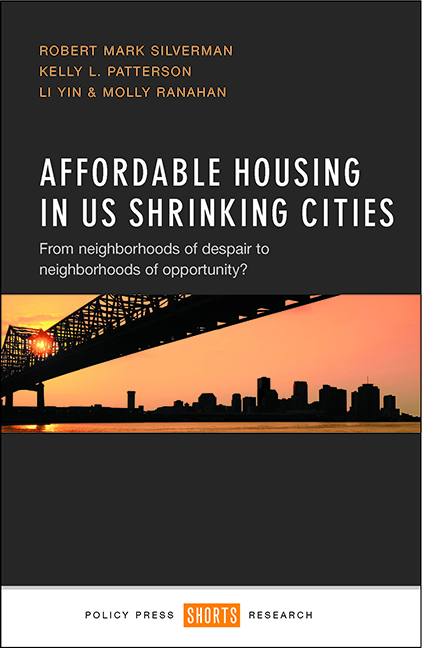 Affordable Housing in US Shrinking Cities
Affordable Housing in US Shrinking Cities Book contents
- Frontmatter
- Contents
- List of tables
- List of figures
- List of acronyms
- About the authors
- Acknowledgments
- Preface
- 1 Social equity and siting affordable housing in shrinking cities
- 2 Present-day Detroit
- 3 Present-day New Orleans
- 4 Present-day Cleveland
- 5 Present-day Pittsburgh
- 6 Present-day Buffalo, New York
- 7 Lessons learned and recommendations for siting affordable housing
- References
- Index
Preface
Published online by Cambridge University Press: 01 September 2022
- Frontmatter
- Contents
- List of tables
- List of figures
- List of acronyms
- About the authors
- Acknowledgments
- Preface
- 1 Social equity and siting affordable housing in shrinking cities
- 2 Present-day Detroit
- 3 Present-day New Orleans
- 4 Present-day Cleveland
- 5 Present-day Pittsburgh
- 6 Present-day Buffalo, New York
- 7 Lessons learned and recommendations for siting affordable housing
- References
- Index
Summary
This book grew out of research conducted for our 2013 Department of Housing and Urban Development (HUD) Sustainable Communities Research Grant (SCRG) titled, “Sustainable affordable housing in shrinking US cities: Developing an analytic tool for siting subsidized housing and evaluating HUD program outcomes.” In that study we developed a comprehensive database for the ten metropolitan regions which contained the fastest shrinking core cities in the US between 2000 and 2010. The cities included: Buffalo, NY; Cleveland, OH; Dayton, OH; Cincinnati, OH; Youngstown, OH; Toledo, OH, Detroit, MI; Pittsburgh, PA; Birmingham, AL; and New Orleans, LA (Frey 2012). Our database included measures of: population and housing characteristics, school performance, transit access, neighborhood amenities, anchor institutions, local job bases, and other spatial attributes. One goal of the project was to identify criteria for siting affordable housing in shrinking cities. Our focus was on identifying emerging neighborhoods of opportunity where sustainable affordable housing could be developed.
Through the course of doing that research we learned that the siting of affordable housing is a context-specific process. Although general patterns for siting affordable housing were identified across the cities we examined (Silverman et al 2015b), the criteria for identifying the institutional composition of emerging neighborhoods of opportunity was dictated by local conditions in each core city. This finding led us to reconsider our recommendations for how local communities approach the siting of affordable housing. Rather than recommending that those processes be driven by a general housing suitability model (HSM), we moved in the direction of recommending that siting decisions be driven by a grassroots decision-making process informed by open source data. The mechanics of this process are outlined in the final chapter of this book.
Another dimension of our research involved the identification of boundaries for neighborhoods of opportunity in shrinking cities. Through our analysis, we became increasingly aware of how these boundaries were shaped by development initiatives pursued by anchor institutions in those cities. Historically, the exact make-up of anchor institutions has ebbed and flowed between coalitions of actors from: private industry, local government, philanthropic organizations, hospitals, institutions of higher education, and other local institutions.
- Type
- Chapter
- Information
- Affordable Housing in US Shrinking CitiesFrom Neighborhoods of Despair to Neighborhoods of Opportunity?, pp. xiii - xviPublisher: Bristol University PressPrint publication year: 2016
